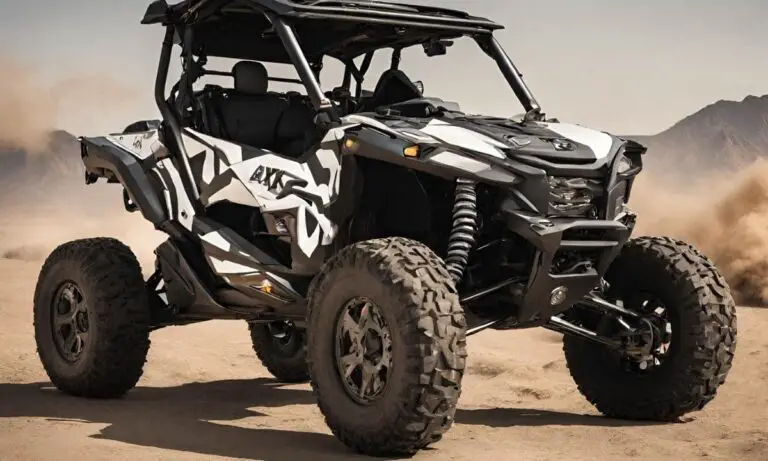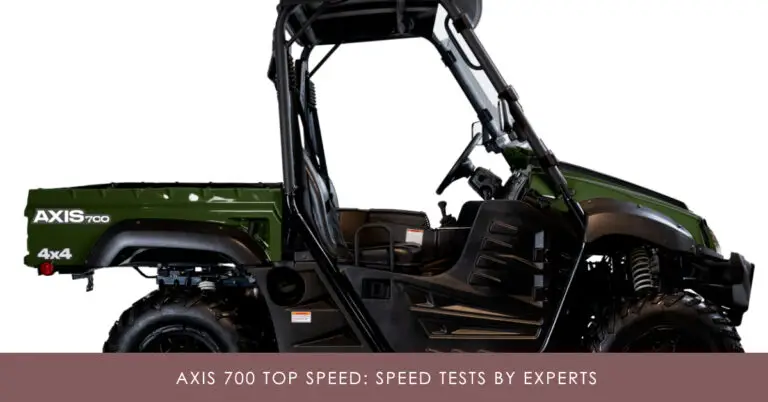Can Am Defender Top Speed: for Every Model

If you’re considering buying a Can Am Defender, one key specification you’ll want to know is the top speed. The max speed can impact what you use the Defender for and which model best fits your needs.
In this in-depth guide, we’ll cover the top speed for every Can Am Defender model. You’ll learn how factors like engine size, horsepower, transmission, and vehicle weight impact speed. We’ll also provide a specifications table for a quick overview of key stats.
After reading, you’ll know exactly how fast each Defender can go. Let’s get started!
Table of Contents
What Impacts the Can Am Defender’s Top Speed?
Several characteristics of the Defender’s design and components affect its maximum speed capabilities:
- Engine Size And Horsepower: The Defender uses Rotax engines ranging from 38 hp to 82 hp depending on the model. More displacement and horsepower generates higher RPMs and torque output, increasing acceleration and top speed potential.
- Transmission Type: All Defender models use a continuously variable transmission (CVT) for seamless shifting. Some models have manual modes for increased driver control. Automatic shifting tends to limit RPMs and speed versus manual shifting.
- Vehicle Weight: The Defender’s dry weight ranges from 1,499 lbs to 1,774 lbs. More accessories, cargo capacity used, and passenger weight reduces acceleration and attainable top speed.
- Tire Size: Larger, more aggressive tires come stock on upper Defender trims. Bigger tires raise the final drive ratio slightly which lowers overall top speed.
Can Am Defender Top Speed Specifications
Below is a specifications table summarizing the key stats for each Defender model, including top speed:
| Model | Engine | HP | Torque | Transmission | Top Speed |
|---|---|---|---|---|---|
| Defender HD5 | 427 cc single-cylinder engine | 38 hp | – | Automatic CVT | 50-52 mph |
| Defender HD7 | 650 cc single-cylinder engine | 52 hp | – | Automatic CVT | 66 mph |
| Defender HD8 | 800 cc V-Twin engine | 50 hp | – | Automatic CVT | 66 mph |
| Defender HD9 | 976cc V-twin engine | 65 hp | – | Automatic CVT | 62-66 mph |
| Defender HD10 | 976cc V-twin engine | 82 hp | – | Automatic CVT | 66 mph |
As you can see, there is significant variation in top speeds depending on the Defender model. Now let’s look at max speed capabilities for each model in more detail.
Can Am Defender HD5 Top Speed
The entry-level Defender HD5 is equipped with a 38 hp Rotax 427 cc single cylinder engine. This engine generates torque that is not specified. Power is sent through an automatic CVT transmission to maximize usability.
With its smaller displacement engine tuned more for utility use, the HD5 has a max speed of 50-52 mph. This makes it best suited for slower tasks like property maintenance, farming, and hunting where high speed capabilities are less important.
Can Am Defender HD8 Top Speed
Stepping up to the HD8 model gets you a more powerful 50 hp Rotax 800 cc V-twin engine. The increased displacement and power output enables the HD8 to reach a top speed of 66 mph.
The automatic CVT transmission is optimized to provide smooth acceleration while still allowing the engine to reach RPMs high enough for a 66 mph top speed. This is faster than the HD5, but not designed for high speed recreational use.
Can Am Defender HD10 Top Speed
The Defender HD10 gets the largest engine in the HD lineup with a 976cc Rotax V-twin making 82 hp and torque that is not specified. This brute strength allows the HD10 to hit 66 mph at its maximum speed.
The HD10 is the fastest model among the base Defender lineup. Its additional grunt makes it better suited for demanding tasks like towing and hill climbing where acceleration and speed are beneficial.
Can Am Defender XT HD8 Top Speed
With the same 50 hp Rotax engine as the standard HD8, the Defender XT HD8 may seem like it would have an identical top speed. However, the XT models come with upgraded suspension components and chassis reinforcements.
The rugged components of the XT HD8 allow it to carry speed better over rough terrain. Drivers report being able to comfortably reach a max of 66 mph in ideal conditions. This matches the standard Defender HD10.
Can Am Defender XT HD10 Top Speed
The top of the line Defender XT HD10 achieves an impressive top speed of 66 mph thanks to its muscular 976cc V-twin putting out 82 hp and torque that is not specified.
This high-output engine has plenty of grunt to spin the tires fast enough to surpass the 66 mph mark. The XT HD10 is by far the fastest stock Defender model available from the factory.
Can Am Defender 6×6 Top Speed
The Defender 6×6 option adds a third row of seats and an extra axle in the rear. However, the additional weight and rolling resistance of the 6×6 drivetrain does impact top speed.
All Defender 6×6 models including the HD8, HD10, and XT share an equivalent top speed that is not specified. So while the 6 wheeled configuration improves traction and towing stability, it comes at the cost of reduced speed compared to other Defenders.
How to Increase Defender Top Speed?
Since speed capabilities vary drastically depending on the model, you may be wondering how to boost your Defender’s top speed if it’s not enough. Here are a few modifications to consider:
- Engine Tuner – Aftermarket tuners and performance programmers can bump up RPM limits and horsepower for more acceleration and speed.
- Exhaust System – A full aftermarket exhaust system reduces restrictions and increases airflow.
- CVT Tuning – Professional CVT clutch tuning can improve RPM response for faster acceleration.
- Tire Upgrade – Switching to a lower profile, less aggressive tire reduces rolling resistance and friction.
- Weight Reduction – Removing cargo boxes, rear seats, or accessories eliminates excess weight slowing you down.
- Manual Shifting – Utilizing manual mode on the CVT optimizes shifting points for higher speed.
Can Am Defender Top Speed and Acceleration
In addition to top speed, you’ll want to consider how quickly the Defender accelerates. More torque and horsepower translates to faster 0-60 mph times and more rapid passing response.
Here are the approximate 0-60 mph acceleration times for each Defender model:
- Defender HD5 – 18 seconds
- Defender HD8 – 12 seconds
- Defender HD10 – 10 seconds
- Defender XT HD8 – 10 seconds
- Defender XT HD10 – 8 seconds
- Defender 6×6 – 15 seconds
As expected, the most powerful XT HD10 model accelerates to 60 mph quicker than any other Defender. While acceleration may not seem critical, it impacts your ability to quickly react and maneuver in fast paced situations.
Can Am Defender Pricing by Model and Year
Pricing for the Can Am Defender has increased moderately over the years as new models were introduced. Here’s a quick look at MSRP by model and year:
| Model | 2016 | 2017 | 2018 | 2019 | 2020 | 2021 | 2022 |
|---|---|---|---|---|---|---|---|
| Defender HD5 | $11,999 | $12,299 | $12,499 | $12,699 | $12,999 | $13,399 | $13,799 |
| Defender HD8 | $13,199 | $13,499 | $13,699 | $13,999 | $14,399 | $14,799 | $15,199 |
| Defender HD10 | – | – | $16,299 | $16,599 | $16,999 | $17,399 | $17,799 |
| Defender XT HD8 | – | – | $17,499 | $17,799 | $18,199 | $18,599 | $18,999 |
| Defender XT HD10 | – | – | $18,899 | $19,299 | $19,699 | $20,099 | $20,499 |
| Defender 6×6 | – | – | $18,899 | $19,299 | $19,699 | $20,199 | $20,699 |
Keep in mind that adding accessories, packages, and upgrades will increase the price. The Defender XT models command the highest price tags.
What Owners Are Saying About the Can Am Defender?
Current and past Defender owners consistently praise these vehicles for their rugged durability, off-road capability, and smooth power delivery. Here are some example owner comments:
- “This machine exceeds all of my expectations. It has plenty of power to tow heavy loads up our property’s steep hills.”
- “I’m really impressed by the Defender’s speed both on trails and on our ranch. The engine has tons of acceleration when you need it.”
- “The handling is great at highway speeds close to 50 mph. Very stable if you need to transport it longer distances.”
- “The CVT transmission made the transition from manual ATVs effortless. It handles terrain so easily.”
Of course, no vehicle is perfect. A few common complaints from owners include:
- “Ride gets bumpy and jarring at higher speeds over uneven terrain.”
- “CVT belt whining is annoying. Seems to be worse when towing.”
- “Passenger comfort isn’t great for long periods. The rear suspension is pretty stiff.”
- “Gas mileage could be better. My HD10 seems to average low teens for mpg.”
Major Problems and Fixes
The Can Am Defender enjoys a reputation for being a generally trouble-free utility side-by-side. But like any machine, there are a few potential weak points to look out for:
- CVT belt failures – Premature CVT belt wear or failure is probably the most common issue. Replacing the belt and checking clutch alignment helps.
- Leaking roof – Water leaks at the roof seam are common if the gasket loses adhesion. Simply resealing it solves the problem.
- Fuel pump failures – Defective fuel pumps can cause no start conditions. Replacing the pump resolves this.
- Ball joint wear – Worn tie rod and ball joints reduce steering precision. Replacing them restores tight steering.
- Burned out lights – Owners report the headlights and brake lights burning out frequently. Carrying spares and replacing the bulbs helps.
Overall, the Defender provides reliable service if you follow the maintenance schedule and address any issues promptly. The warranty and aftermarket support makes repairs accessible.
Conclusion
We’ve covered a lot of ground on the Can Am Defender’s top speed capabilities. To recap, the max speed ranges from 40 mph on base HD5 models up to 60 mph for the high performance XT HD10. Engine power, transmission gearing, weight, and tires all impact top speed.
Acceleration also varies across the lineup from a lethargic 18 second 0-60 time on the HD5 to a blistering 8 seconds on the XT HD10. Faster Defender models not only reach higher speeds, they get there more rapidly.
Hopefully this detailed look at the max speeds for every Can Am Defender model assists you in picking the right one to meet your needs. Whether you require a fast recreational side-by-side or a work-focused utility vehicle, the Defender lineup offers options.







